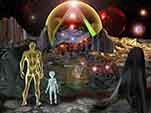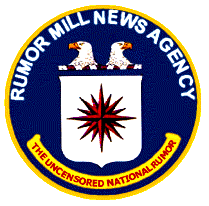The following is my transcript of comments made by a woman named Debra Von Trapp, who was interviewed live on "Truth, Inc.," a cable-access television show then being carried by Comcast of New Haven; the air date was May 31st, 1995, at 9:00 pm EDT.
The host -- George W. Edwards. The show lasted one hour and she was in segment #2, which consumed most of the time that evening:
The first question he put to her was about her status as a nationally-known computer analyst, and expert working in a
special "multi-agency" task force, called National Network Surveillance, with various contract employees and senior federal agents:
Debra Von Trapp: "We reported not only to the Executive Office of the President, but also to Gunter Air Force Base ....
"As a result of being a part of that group of individuals which were comprised of federal personnel from the C.I.A., F.B.I., and Defense Intelligence agencies, I was with them during a surveillance project on the Perot petition committees' activies,
and when Mr. Clinton won the election, they hadn't counted on that. And the person who headed that team, a senior F.B.I. man named Robert Goetzman -- panicked and proposed that the C.I.A., with a black budget, fund a surveillance project of the Clinton administration, since their boss and previous C.I.A. director George Bush had lost the election.
"Apparently he wasn't able to obtain that authorization, was unwilling to give up the gravy train amount of funds that they had been receiving, and the autonomy that they experienced on this special team that they were operating on...
"And [he] walked into the embassy of Japan, which he had previously had contact and a relationship with, and
constructed an agreement with the Japanese government, and Ambassador Kuriyama, which was ultimately funded from Tokyo through an entity called MCA Universal, a wholly-owned subsidiary of a company called Matsushita.
"Ultimately, that agreement was to -- with Japanese funds -- to have these federal employees print MCA Universal business cards with their names on them and additionally operate front companies which produced or provided computer technology. And they placed an operation into effect which ultimately became a large
espionage operation, a surveillance of the Clinton administration starting with the inaugural activities and culminating in the complete placement of bugging and surveillance equipment in the new executive office of the President, the Democratic National Committee, certain offices of the District of Columbia, including the Metropolitan Police Department.
"And the last project that I worked with them on was placement of five bugged video boards which were installed inside five generals' computers at the Pentagon.
"And, at that point, I turned them into Secretary Perry."
George W. Edwards: "You made a report to the Secretary of Defense of the United States?"
DVT: "Yes."
GWE: "That technology in the hands of U.S. federal agents had been placed in their facility for electronic surveillance on behalf of the Japanese government?"
DVT: "Yes. And, ultimately, with that information, and ... prior to the administration taking me seriously, or taking any action ... the military acted first.
"And one of the first things that was done, was that they placed me at the door of the Nixon library during Mr. Nixon's funeral... next to a Secret Service agent right at the door, so each of the Presidents walked past me, and additionally, the Japanese government visitors had to walk directly in front of me across the sidewalk. I was placed there as a silent message, at that time, back to George Bush and the Japanese government that the U.S. military was aware of the compromise -- and the C.I.A., F.B.I. and Japanese government participation in that.
"You have photos, I believe, at your studio that were transmitted by fax showing my position at that funeral.
"Ultimately, what happened is I went to Janet Reno's office,
[pause] I actually sent them in documents.
"She initiated an investigation in July of 1994, and by August of '94, Paul Coffee, who is the chief of the organized crime and racketeering section, killed that investigation when he understood which senior intelligence officals were involved. Actually destroyed and removed the documents from the Justice Deparment building, and made sure that none of the documents were referred to the F.B.I. for any kind of investigation.
"Not only did Janet Reno's stafff confirm that the F.B.I. was never given any of the documents -- but Paul Coffee's own office -- his staff, and his secretary confirmed that he had destroyed them, and instructed his staff to 'hang up on me' if I called into the office to try to pursue the matter.
"I ultimately went to Ambassador Mondale by communication with the American embassy in Tokyo. And, Mondale and his attorney for the embassy communicated with me, and understood the information that I had. They believed it was good information.
"Mondale and Mickey Kantor flew to Washington, met with President Clinton regarding this, and contemporaneous with that meeting, Alan Whicher, the Secret Service agent that had been on the protection detail for both Bush and then Clinton, and had been instrumental in giving Goetzman and his associates -- Wes Thomas, Peter Stanley, and Jim Kofield [spelling uncertain] and others, access to not only the executive office, but other areas in which the President was either present or travelled to, in order to surveill him, and place equipment on behalf of the Japanese goverment.
"Alan Whicher was bounced out of the White House back to the Secret Service office at the Oklahoma City federal building."
GWE: "Mr. Whicher is deceased and a victim of this bombing?
DVT: "Yes. And, in fact, during the memorial service that was televised in Oklahoma City, Alan Whicher's widow and his daughter sat directly behind Bill and Hillary [Clinton] as a silent message. The President and his wife sat directly in front of them, so that each time the camera looked upon the president, the audience and the Japanese government and anyone viewing that would see Whicher's widow and daughter in the frame with the President and his wife."
GWE: "The other gentlemen whose names you called -- what agencies of the government do they work in?"
DVT: "To the best of my knowledge, Jim Kofield originally --
and you have to keep in mind that a lot of these intelligence employees actually hold civilian positions, as cover positions concurrent with their federal employment -- but to the best of my knowledge he was at AT&T, and was also a Defense Intelligence Agency employee.
"He travelled, and spent a lot of time between Fort Wachuca in Arizona and Fort Mead. Wes Thomas is known to be a surveillance expert, uh... extremely astute in bugging equipment, and he is known to be a C.I.A. employee. Goetzman is a senior F.B.I. official, however he has what they call dual-agency, and operates in either agency at the level of, um, his authority.
"There was another person -- Peter Stanley -- who, in fact, was the person that sold Hillary, her first purchase order, was for a MacIntosh computer. Peter Stanley delivered it, with, to the best of my knowledge, a monitoring... a chip, that would transmit whatever she was communicating, typing, whatever, on that machine
-- he placed that equipment with her under her first purchase order. He is, to the best of my knowledge, F.B.I., subordinate to Robert Goetzman."
GWE: "OK! Now. You've given us some background ... leading up to the point, where we want to, as they say in the business, 'cut to the chase.'
"I would like for you to set up the scenario, of the terror of the nerve gas deaths that took place in Japan -- and how do you think this occurred, and who is responsible for this?"
DVT: "I believe, based on the information that I've been given, from intelligence sources and people who were attempting to assist me and protect me, that the Sarin attack in Kobe was in fact a U.S. military operation that was initiated in retaliation for compromise of White House communications, which is a military
responsibility, even though people always think of the White House as a Secret Service responsibility, all of the
communications is a military operation.
"The fact that that took place, was, uh, going to take place, was apparently anticipated or leaked, and one of the things that was done just immediately before, just days before that attack, was that the Japanese government responded by immediately and seriously devaluing the dollar. In an attempt to put pressure on the U.S. And in fact, it dropped from a hundred yen all the way down, at the date of the bombing, it was actually at
seventy-nine yen. And, additionally, there was a second attack, shortly thereafter ... the dollar had risen in value, and then was, coincidentally, at seventy-nine on the date of the second attack.
"The bombing in Oklahoma City is actually -- the April 19th date is not important, and isn't applicable. It was April 20th in Japan, and that was the one month anniversary date of the subway attack.
"Something very important happened in-between the subway attack and the Oklahoma City bombing. And that was, MCA-Universal, the Japanese-owned company, the wholly-owned subsidiary of Matsushita that was, uh, employing and paying the funds for these intelligence agents, uh, had in fact removed all of their corporate records into storage, a week after the subway attack.
"They moved them to a storage facility in southern California called Data Lock, which is Japanese- owned .... That same storage facility was the place that we, when I say we, I mean me, Goetzman, Kofield and others, shipped the bugged equipment into and out of, that ultimately ended up in the executive office, and the D.N.C., and those other locations."
GWE: "So -- there's industrial intelligence operations going on at the highest level of government, with private, corporate technology being utilized by ... directed by, U.S. federal intelligence agents on behalf of a foreign government against the U.S.?"
DVT: "Yes! And something that's even more startling to me, that I discovered concurrent to this, was that Data Lock storage facilty was, last year, in a bid process, awarded the Hughes aircraft record storage contract, and Hughes Aircraft in California is one of the largest federal defense contractors in the country. So, not only were the Japanese participating in all of this, with MCA-Universal fronting and funding this, they actually had
control of Hughes Aircraft documents within their own facility all of that time."
[Questions about how many B.A.T.F. agents were present and how many were absent in Oklahoma City, the day of the bombing, are omitted here. Von Trapp notes that no children of A.T.F. employees were in the daycare center at the A.P. Murrah building
on that day.]
DVT: "Tim McVeigh was an after-thought ...."
GWE: "So you're saying, that all of the militia people, whoever they may be, named or un-named, are not part of this whole business of this bombing, including [Timothy] McVeigh?"
DVT: "Exactly. What happened was, when this building came down, Janet Reno. and people who had to account for this activity, that had not been privy to the actual information that this was going to happen, and that was the target, panicked and had to come up with a story. They immediately came up with trying to spoon-feed the American public with a look-alike story to the New York City bombing [World Trade Center], and thought that would be easy for everyone to digest.
"And then they went on this Arab hunt, and when that didn't pan out and they weren't going to able to come up with anything to follow through and feed the public... someone in the F.B.I. in Oklahoma noticed that they had a militia-related, [loner] up the road in custody on some charge -- and they went into a tailspin.
"And from there back-tracked and tried to create evidence against Tim McVeigh. And it's not any coincidence, that his initial counsel commented to the media that either this man was A) the most brilliant liar, and the most brilliant bombist ever known, or this was just a kid who didn't know a thing .... And the answer is B!"
"He simply was in the wrong place at the wrong time -- had nothing to do with this -- and, uh, the most that they'll ever... be able to associate either he or Nichols with, at all, is the fact that Nichols apparently experimented with some very small- time charges, homemade bombs, on his property and that activity was completely unrelated to this."
GWE: "For my viewing audience ... Give us here in Connecticut what you perceive this whole business is about, in a nutshell. The bombing, the gas attack ...."
DVT: "This is about trade war -- a trade war that escalated into an undeclared war between Japan and the United States -- when they were desperate for some advantage in a trade war that was ultimately getting out of control -- sanctions and economics -- and the financial control that the Japanese hold, especially over banking and other segments of our economy.
"And it drove them to desperate measures, and has ultimately resulted in the compromise of this administration, our national security, and ... has driven us to a point where ... the fact the FBI especially has a hidden agenda regarding their surveillance and control of the U.S. population on behalf of a few people who
are actually in power, and aren't sitting at the executive office, that whole circumstance has become transparent.
"And now, the whole situation is out of control.
"But the initial impetus for this was the trade war and the great imbalance in the trade deficit."
GWE: "So it's your view that the bomb or bombs were inside the building, and not outside the building? And they were not nitrate-fertilizer and diesel fuel bombs?"
DVT: "This was a very special, highly sophisticated, dual-charge bomb, that was placed there by what I'll describe as a
"special ops" type team, contracted by Robert Goetzman on behalf of the Japanese government. And that team actually came out of a facility in Alabama -- and the persons that actually placed that bomb in the building are still active duty personnel not acting on behalf of their own commander, and they are located in the State of Alabama."
GWE: "On a military installation?"
DVT: "Yes they are."
GWE: "To the people who are disbelievers, for the skeptics ... in a state of... shock, what could you say to this audience ... to keep an open mind?"
DVT: "Start trying on their own to gain more information about what the relationship was between the downed military aircraft, that was downed two days before that building went down, that crashed in Alabama, with high-ranking Air Force personnel aboard, attached to Gunter Air Force Base -- that were ... in charge of
the acquisition of technology for the Air Force. And, that connection between those gentlemen to whom Robert Goetzman and I and others reported, on the National Network Surveillance Project. And, ultimately, Alan Whicher and the compromise of the White House; and when all that information finally surfaces, they
will have the answers to what happened that day."
Two of the men who were killed on April 17, 1995, were Maj. Gen. Glen A. Proffitt II and Clark Fiester. Mr. Fiester, formerly of Mountain View, California, and had links to many high-tech, defense industry experts. He was, I believe, an Associate Secretary of Defense at that time. Also on that day, there was another Sarin gas attack in Tokyo. Perhaps someone more aware of the Air Force's development and training can indicate just what General Proffitt's role was at San Antonio, Texas. In a separate interview, Debra Von Trapp claimed that Robert Goetzman called her on the day Vincent Foster died and told her, in an excited voice, "we hit him! we hit him!" She said that they had killed him "to send a message to that queer Hillary and her husband."
There is more to report on this linkage -- the software installed on the compromised computers sold to the Clintons and placed in the White House by Goetzman and his associates, says Von Trapp, had "trap doors" in them that allowed E-mail traffic to be directly routed to the Embassy of Japan; and that similar soft ware -- Word Perfect versions for which they cheated both the government purchasing office and Novell Corporation, by making illegal copies and not paying the license fees -- were installed at the Democratic National Committee and in the metro government of the District of Columbia. That means that the Embassy of Japan and their minions at Matsushita were privy to the influence peddling of John Huang and his operation at the Department of Commerce, almost in real time, and thus well-before anyone else in the public knew that he was servicing his masters in the Lippo Group and through them, the hierarchy of the government of China.
And this all ties in to Jackson Stephens, doesn't it?






































